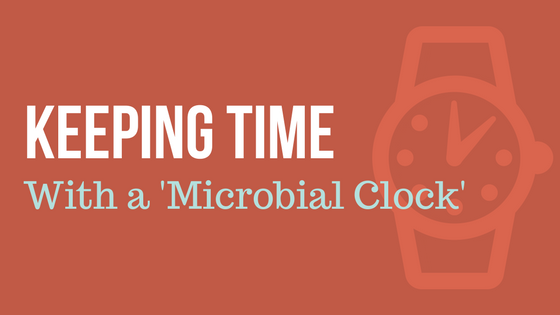When a dead body is discovered, two of the most important questions are “When did this person die?” and “How did this person die?” Recent advances in microbiology and genomics coupled with the decreasing costs of DNA sequencing show that forensic investigators may one day have another tool in their arsenal – microbes.
written by: Tara luther, promega
Researchers have already shown that microbes have the potential to influence toxicology results, help uncover the cause of death, and prove that a suspect was at the scene of a crime. Now, in a recent article in PNAS, researchers at Colorado Mesa University are looking to prove that microbes are predictably found at certain times during the decomposition process. Doing so, would allow crime scene investigators to rely on this “microbial clock” to help estimate time of death, and potentially the cause.
Currently, investigators rely on the postmortem interval, or estimates of the time since death, to begin to determine what happened to a victim and to authenticate a potential suspect’s alibi. Factors contributing to the postmortem interval include activity on the victim’s credit card, when they were last seen alive, and the state of the body. In certain cases, insect species found on the body can be a clue as well, but it’s not possible to rely on insects alone.
The term “microbial clock” originated from Jessica Metcalf, a microbial ecologist and evolutionary biologist at Colorado State University who leads the FIRS project. In 2010, she decided to shift from using DNA to study Ice Age mammals to working with ancient humans, specifically understanding their gut microbes by studying feces. As Metcalf was studying remains, she thought it wise to gain knowledge on the microbes involved in decomposition, which led her to Rob Knight of the University of California, San Diego, who was researching forensic uses for the microbiome profiles of living people. Metcalf then brought the study to Melissa Connor, a forensic anthropologist and director of FIRS at Colorado Mesa University. Rounding out the team are colleagues at the Forensic Anthropology Center at the University of Tennessee, Knoxville and the Applied Anatomical Research Center at Sam Houston State University in Texas.
Connor helped Metcalf with the design of the study and also coordinates with funeral homes and donor families to receive new bodies for the research. For this study, Connor placed 12 bodies in a dry sagebush field, 3 in each season. Their colleagues in Tennessee and Texas followed suit. In Tennessee, the bodies reside on well-drained clay under oak, maple, and hickory trees, and in Texas they were placed on sandy, acidic soil amidst loblolly and longleaf pines.
When the bodies are placed, the team takes swabs from the skin on the cheek and hip bone as well as the surrounding soil, and then take new samples every day for three weeks. All of the samples are sent to Metcalf for DNA extraction, and then the DNA is sent to Knight for sequencing. Once this is done, Metcalf and her team perform a series of genomic analyses which allow them to study entire pools of microbes at one time. Metcalf believes that the “microbial clock” will be made of groupings of microbial species that rise and fall in a complex, predictable fashion over time.
The first bodies in this study were placed in 2016, so the results have not yet been published, but prior work done with four human cadavers at the Texas facility in 2013 was promising. In that study, Metcalf was able to show that microbial successions were consistent across different human bodies and different seasons, even when accounting for seasonal temperatures. In her current research, she’s noticed microbial species making up the postmortem microbiome do vary slightly depending on geographic region, but has noted that not every microbe in a community is equally important.
Metcalf and her team are not the only ones working on proving a “microbial clock”. Jen Pechel of Michigan State University and Carl Schmidt of the Wayne County Medical Examiner’s Office have been working to determine if they can identify a “microbial clock” using bodies from the Medical Examiner’s office. These bodies were exposed to real-world conditions and varying environments, both indoors and outdoors. Pechel and Schmidt studied bodies with confirmed times of death in order to verify the accuracy of the microbiome, and took swabs from six regions on the body.
Next, Pechel analyzed the swabs to determine whether bodies that had been dead for the same amount of time showed a similar microbial presence and activity. Since the cause of death is known for these bodies, Pechel was also able to look to see if the cause of death effected the “microbial clock” in any way.
To date, Pechel’s team has sampled 1,000 bodies and completed genomic analyses on 200. They are starting to see that key bacteria and key functions change during the decomposition process, and they can at least determine whether 48 hours have passed since the time of death.
As to whether the “microbial clock” will be used anytime soon? Probably not. Though Metcalf feels she’ll be able to test her clock on a real crime scene scenario within two – five years, there are other obstacles. First, the Scientific Working Group on DNA Analysis Methods would first need to validate and approve the method. Second, the cost of doing the lab work may also be prohibitive. Most medical examiners’ offices don’t have molecular support labs, which would necessitate outsourcing to private labs. Finally, in criminal cases, a judge would need to determine that the “microbial clock” meets the standard for admission of expert testimony. Even with all these hurdles, forensic investigators may one day be able to look to the clock for answers.
WOULD YOU LIKE TO SEE MORE ARTICLES LIKE THIS? SUBSCRIBE TO THE ISHI BLOG BELOW!


